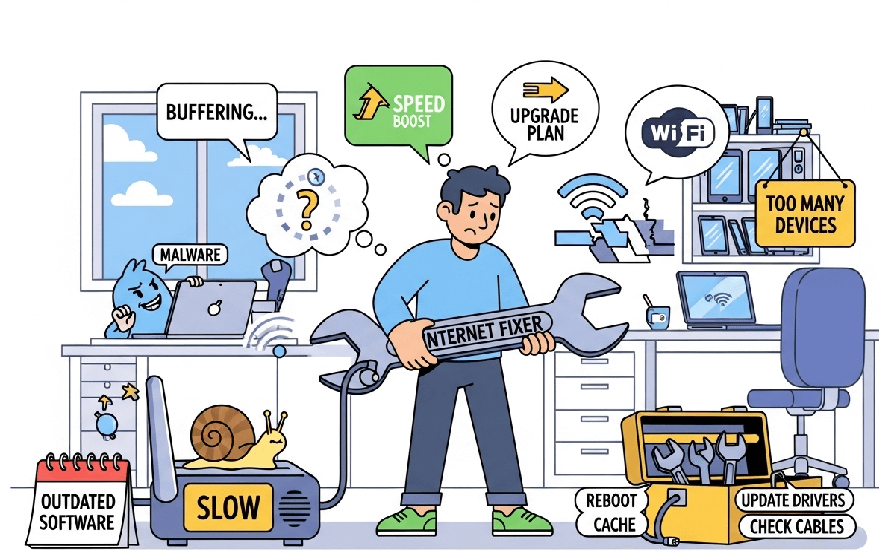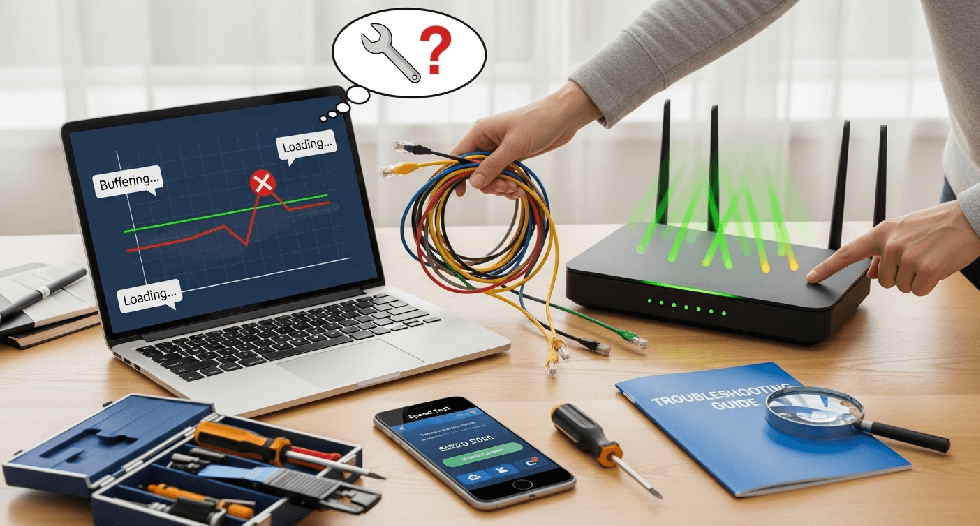Are you tired of staring at a buffering screen? A slow internet connection can be a major frustration. This guide will walk you through the common causes and provide actionable steps on how to fix a slow internet connection, getting you back up to speed in no time.
Quick Fixes for a Slow Internet Connection
Before diving into more complex troubleshooting, let’s start with the basics. These simple steps can often resolve common internet speed issues.
Restart Your Modem and Router
It’s the oldest trick in the IT book for a reason: it works. Restarting your modem and router can clear up temporary glitches and refresh your connection. Simply unplug both devices, wait for about 30 seconds, then plug them back in.
Check Your Internet Speed
To know if your internet is truly slow, you need to know what you’re working with. Use a reliable speed test service to measure your current download and upload speeds. Compare these results to the speeds you’re supposed to be getting from your internet service provider (ISP).
Reduce Network Congestion
If you have multiple devices connected to your network, you might be experiencing network congestion. Try to limit the number of devices using the internet at the same time, especially for bandwidth-heavy activities like streaming or gaming.
How to Fix a Slow Internet Connection: Deeper Dives

If the quick fixes didn’t do the trick, it’s time to investigate further. Here are some more advanced troubleshooting steps for your home network.
Optimize Your Wi-Fi Signal
A weak Wi-Fi signal is a common culprit for slow internet. Physical obstructions like walls, furniture, and even other electronic devices can interfere with your Wi-Fi signal.
- Router Placement: Position your router in a central, elevated location. Avoid placing it in closets or behind furniture.
- Antenna Position: If your router has antennas, make sure they are pointing upwards for the best horizontal reach.
- Wi-Fi Extenders and Mesh Networks: If you have a large home, consider a Wi-Fi extender or a mesh network to boost the signal in hard-to-reach areas.
Switch Your Wi-Fi Frequency Band and Channel
Modern routers broadcast on two frequency bands: 2.4 GHz and 5 GHz.
- 5 GHz: This band provides faster speeds but has a shorter range. It’s ideal for devices that are close to the router and need high speeds, like streaming devices or gaming consoles.
- 2.4 GHz: This band has a longer range but offers slower speeds. It’s better for devices that are farther away from the router.
Log into your router’s admin settings to see if you can switch devices between these bands.
You can also try changing your Wi-Fi channel, as this can help you avoid interference from your neighbors’ networks.
Check Your Equipment and a Wired Connection
Your hardware can play a significant role in your internet speed.
- Ethernet Connection: Try connecting your computer directly to the router with an Ethernet cable. If your internet is faster with a wired connection, the issue is likely with your Wi-Fi.
- Inspect Cables: Check your Ethernet and coaxial cables for any damage or loose connections.
- Update and Upgrade: Ensure your router’s firmware is up to date. If your router is more than a few years old, it might be time for an upgrade to a newer model that can support faster speeds.
Address Software and Security Issues
Sometimes, the problem lies within your devices themselves.
- Background Applications: Close any applications or browser tabs you’re not actively using. Some apps run in the background and consume bandwidth without you realizing it.
- Clear Cache: Clear your browser’s cache and your computer’s DNS cache to resolve potential conflicts.
- Malware Scan: Run a virus and malware scan on your computer. Malicious software can run in the background and slow down your internet connection.
Is Your Plan or Provider the Problem?
If you’ve optimized your home network and still face a slow internet connection, the issue might be outside your direct control. Here’s what to look for.
Check Your Internet Plan’s Speed and Data Caps
Take a close look at the details of your internet plan. You might be paying for a lower-tier speed that is no longer sufficient for your needs.
Furthermore, some plans have a monthly data cap. If you exceed this limit, your ISP may drastically slow down your service for the rest of the billing cycle.
Understand ISP Throttling
Internet throttling is when your ISP intentionally limits your bandwidth.
This often happens during times of high network congestion or if they detect activity that uses a lot of data, such as torrenting or constant 4K streaming.
While difficult to prove, if your speed consistently drops at the same time every day, throttling could be the cause.
Are You Using a Slow VPN?
A Virtual Private Network (VPN) encrypts your traffic, which can sometimes slow down your connection.
If your internet is only slow when your VPN is active, try connecting to a different server that is closer to your physical location.
When to Call Your Internet Service Provider (ISP)
If you’ve tried all the steps above and your internet is still slow, it’s time to contact your ISP. Armed with the information from your speed tests and troubleshooting, you can have a more productive conversation.
The issue could be on their end, such as network congestion in your area or a problem with the lines coming into your home.
Frequently Asked Questions
What causes slow internet?
Slow internet can be caused by a variety of factors, including network congestion, weak Wi-Fi signals, outdated equipment, ISP throttling, and having an internet plan that is too slow for your needs.
What is a good internet speed?
A good internet speed depends on your usage. For basic browsing and email, 25 Mbps is sufficient. For streaming HD or 4K video and online gaming, you’ll want at least 100 Mbps.
Why is my internet slow at night?
Internet speeds can slow down at night due to network congestion. This is a peak usage time when many people in your area are online, which can overload the network.
Read also: How to fix overheating laptop
Conclusion
Fixing a slow internet connection doesn’t have to be a daunting task. By following these troubleshooting steps, you can identify the root cause of the problem and take the necessary actions to improve your internet speed. From simple restarts to investigating your internet plan, you have the power to enhance your online experience. If you found this guide helpful, share it with others who might be struggling with a sluggish connection.
IT Security / Cyber Security Experts.
Technology Enthusiasm.
Love to read, test and write about IT, Cyber Security and Technology.
The Geek coming from the things I love and how I look.

